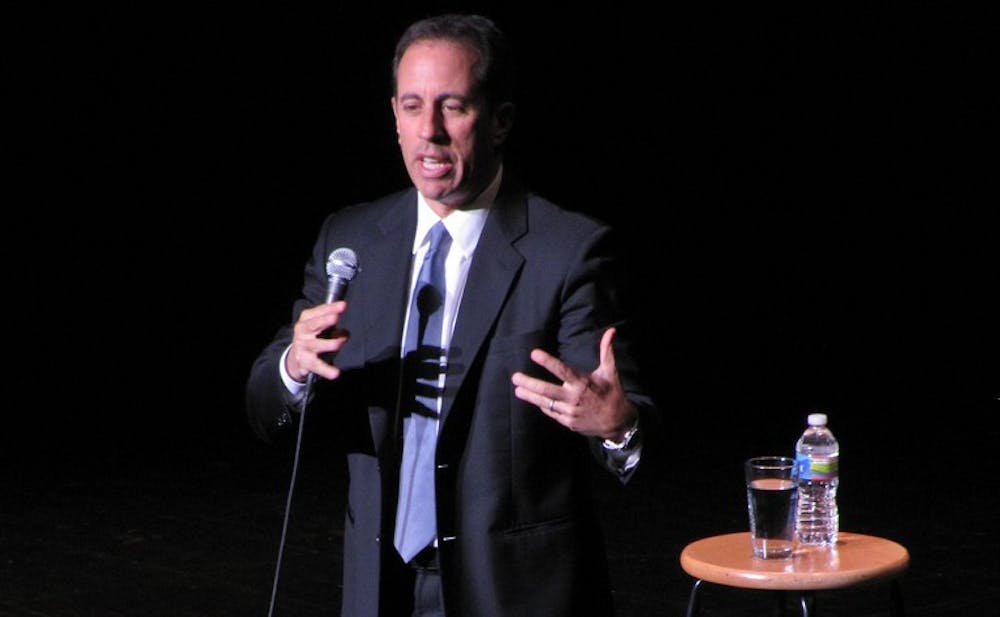There are very few things that I would drop $100 for: renting a “used" textbook from the Duke Store, buying a glorified pedometer, and getting a ticket to see the great Jerry Seinfeld perform his stand-up.
On the night of Sept. 11, Jerry Seinfeld performed two sold-out shows at the Durham Performing Arts Center as a part of his recent comedy tour. More than a decade after his hit show finished its nine-year run on NBC, Seinfeld is still very prominent in the entertainment industry. When not chatting with other comedians in cars over coffee on the online streaming site Crackle, Seinfeld still continues to bring his witty style of observational comedy around the country and overseas.
The opener for Seinfeld's act was Larry Miller, best known for his role in the movie "10 Things I Hate About You" and as the bitter doorman on "Seinfeld." Miller primed the audience with jokes on a variety of subjects, including the lack of compatibility with his wife, Little League mothers vs. terrorists and society’s perception of age. Miller's performance gave the audience a healthy calm before the roar that was to come.
Seinfeld's set comprised of jokes ranging from married life to hypothetical Viagra mishaps to the problem with energy drinks to the very audience experience of watching his standup. What Seinfeld has always done best is finding the peculiar minutia in our everyday lives, expanding on this minutia to bizarre measures and constructing his observations into a hilarious joke. Seeing as though the last stand-up act I saw was Bill Cosby pre-sexual assault allegations, I can say for certain that Seinfeld's act was more entertaining and exciting than Cosby's, which was boring and confusing.
Seinfeld's act in 2015 serves as an emblem that relatively clean comedy can still survive and kill audiences across the country. His performance was a mix of previous material and a few newer bits, but for the audience that night, it seemed that nobody knew the difference. With the prominence of raunchier comedians like Amy Schumer and Louis C.K., Seinfeld primarily appeals to the demographic that were adults watching his TV show and stand-up in the 80s and 90s. Looking around the theater, most members of the audience member appeared to be over the age of 35, with the occasional kid being dragged along by their parental units.
The evolution of the obscure and edgy comic began with comedians like Richard Pryor and progressed with the likes of Joan Rivers, George Carlin, Eddie Murphy and Chris Rock. Comedians like Seinfeld and Ellen DeGeneres restrained their humor to everyday experiences that taunted the taboo but never fully embraced it. However, this form of mass appeal is no less funny, it only jives differently from the current popular trends of comedy like stoner humor, sex comedy and anecdotal-heavy sets.
Recently, Seinfeld has been critical of society's growing taste to be overly politically correct. He particularly pointed out that college students are more sensitive to political correctness and take the first opportunity to declare something as racist, sexist or prejudiced. This obsession with political correctness is what Seinfeld has deemed detrimental for comedy. If people are taking issue with Jerry Seinfeld’s relatively unprovocative material, then there is an issue. While this fascination with political correctness cannot be generalized to the entire college demographic, there is no question that comedy that triumphs on campus is more attuned to the restrictions of political correctness to a degree. The dubious jokes that stretch the bounds of society are not as well received as a sex joke or very clever pun.
Regardless, one thing that was truly evident on Friday night's performance was how well Seinfeld commanded the stage. More animated and with a greater stage presence than his opener, Seinfeld spared no occasion to physically accompany the punch lines to many of his jokes. For example, in the joke about a man who "waddled" into his doctor's office wearing a poncho after a Viagra-induced erection lasting more than four hours, Seinfeld hobbled around and deftly employed the microphone to paint a clear and relatable image. The way Seinfeld structured his jokes so that a succession of punch lines led to a crescendo of booming laughs was remarkable and a testament to his mastery of the art of stand-up.
According to my Uber driver, who was a volunteer at the earlier show, Seinfeld took down a heckler in the audience that called him out for not discussing the events of 9/11 in his act. Seinfeld responded that he is a comedian, and his job is to make people laugh with his comedic routine, not reflect on a tragedy. Seinfeld continued to say that he just wants everyone to have a good time to which he addressed the audience, "Am I right?"
This article was updated to clarify ambiguous wording comparing Seinfeld's act to Bill Cosby's.
Get The Chronicle straight to your inbox
Signup for our weekly newsletter. Cancel at any time.

